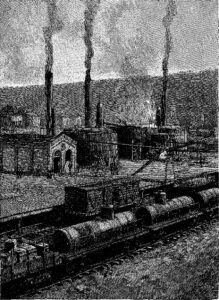From “What Is Monopoly?,” which appeared in the June 1938 issue of Harper’s Magazine. The complete article—along with the magazine’s entire 174-year archive—is available online at harpers.org/archive.
The curtain at Washington slowly rises on the third showing of a perennial drama first presented some fifty years ago amid much fanfare, when Congress fashioned the Sherman Antitrust Act and with it slew the dread dragon of monopoly. The drama repeated in 1914, with the same intrepid congressional Galahad destroying that vicious monster once more. The only difference lay in the substitution of the Clayton Act for the Sherman Act as lethal weapon. Presumably the old sword had lost some of its magic, for no doubt that once again the play will soon be reenacted. The actors are ready, well versed in their roles; only the new weapon remains to be forged.
As in all proper plays, the resuscitation of the villain has awaited only the fall of the curtain, and indeed the immunity with which monopoly has survived its periodic assaults has been attributed to a variety of causes. Legislators have been accused of loose lawmaking and administrative officials of lax enforcement; businessmen have been condemned for evading the law and the courts for interpreting it too liberally. Each allegation has an element of truth, yet all overlook one fundamental difficulty: none of the enemies of monopoly has ever bothered to define what it was he was attacking.
For “monopoly,” in the strict sense of the term, is too rare a factor in the American industrial scene to warrant much concern. Public utilities, of course, are accepted as “naturally” monopolistic and are regulated accordingly, but aside from them, there are no more than a handful of industries in which control is so completely vested in a single company that a true monopoly can be said to exist. So the term “monopoly” has itself acquired a wider meaning than that accorded it by the dictionary. Consequently, certain evils associated with monopoly that occur far more frequently—notably the concentration of economic power and the stifling of competition—had to be controlled by entirely inconsistent means, with state statutes imposing all manner of obstacle in the name of stymieing corporate growth and merger.
It took a stroke of legal genius to circumvent these obstacles, chief of all the epiphany that anyone who wished to avoid the burden of managing his own property could lawfully transfer it in trust. Accordingly, the stockholders of competing oil companies turned their shares over to a board of trustees. This board exercised complete control over all the enterprises whose stock it held, and thus the Standard Oil Trust was born. This masterful solution was soon paid the tribute of imitation, and the next few years witnessed the formation of the Sugar Refining Trust, the Lead Trust, the Distillers’ Trust, the Cordage Trust, the Linseed Oil Trust, and a host of others.

The only flaw in this scheme was that it became too successful. Public opinion, led by small businessmen who felt their interests threatened, suddenly became vocal. Strong pressure was brought upon government agencies to arrest the progress of the trusts. Sentiment crystallized so rapidly that the latter were caught off their guard. In state after state, forgotten statutes were invoked to force the trusts to dissolve. Such was the atmosphere in which the Sherman Act was passed, forbidding these combinations of trade, albeit in somewhat vague and general language.
In 1911, the act achieved its most spectacular victory: the Standard Oil Corporation was ordered dissolved. But this victory was also its costliest. The Supreme Court, in condemning Standard Oil, laid down its “rule of reason,” announcing that the Sherman Act didn’t really mean what it said. After all, said the justices, there could be no objection to the act’s restraint of trade so long as it was “reasonable”; only “unreasonable” restraints could be held illegal. Indeed, not many years later, the court found that the United States Steel Corporation, which then controlled half the steel business in the country, did not trespass the bounds of reason. Other decisions of like tenor soon convinced most observers that the Sherman Act could no longer impede the growth of combinations. At best, as soon as Congress had concluded its labors and gone home, the act gave businessmen occasion to pause—but only briefly.


